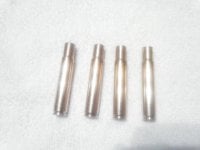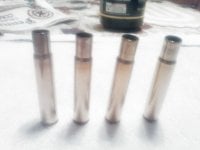truck driver
Ammo Smith
- Mar 11, 2013
- 7,505
- 1,308
I had a couple of my 35 Whelen brass necks split while reloading so I thought I better give it a try. I watched Scotty's U tube post and gave it a whirl.
I got out the torch with map gas and a 1/2" socket and filled a small pan with about 2" of water. I spun and heated the necks in a low lighted room till they were glowing down to the shoulder and then dropped them in the water to cool. Here's a pic of the end results, these were the bad cases since I didn't want to ruin any good ones. So tell me what you think. Should I have stopped before they turned red to the shoulder?
I got out the torch with map gas and a 1/2" socket and filled a small pan with about 2" of water. I spun and heated the necks in a low lighted room till they were glowing down to the shoulder and then dropped them in the water to cool. Here's a pic of the end results, these were the bad cases since I didn't want to ruin any good ones. So tell me what you think. Should I have stopped before they turned red to the shoulder?







